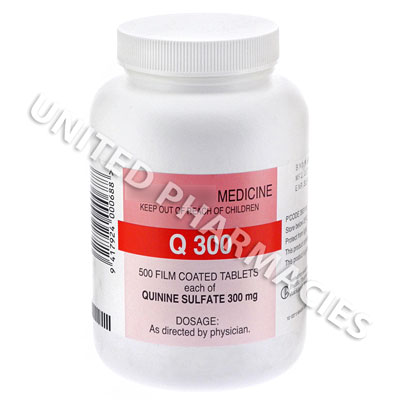Customers also like
Plagril (Clopidogrel Bisulfate) - 75mg (10 Tablets)
our best price : $4.40
Pletoz (Cilostazol) - 50mg (10 Tablets)
our best price : $5.74
Pletoz (Cilostazol) - 100mg (10 Tablets)
our best price : $8.72
Quinin (Quinine Sulphate) - 300mg (10 Tablets)
our best price : $2.25
Falcigo Injection (Artesunate) - 60mg (1 Vial)
our best price : $6.44
Description
Q 300 (Quinine Sulphate) is indicated for reducing the occurrence of nocturnal leg cramps. It is also used against malaria, `unknown` infective species and myotonia.
To minimise gastrointestinal irritation Quinine Sulphate should be taken with or after meals.
Malaria: For chloroquine-resistant Plasmodium falciparum malaria give orally, 600 to 650 mg every eight hours for at least three days in most areas of the world (seven days in Southeast Asia) with concurrent or consecutive administration of 250 mg of tetracycline every six hours for seven days; or concurrent administration of 1.5 grams of sulfadoxine and 75 mg of pyrimethamine combination as a single dose; or concurrent or consecutive administration of 900 mg of clindamycin three times daily for three days.
Nocturnal recumbency leg cramps: Orally, 200 to 300 mg at bedtime and an additional dose of 200 to 300 mg may be taken following the evening meal.
The long term administration of quinine in normal therapeutic doses may give rise to a train of symptoms known as cinchonism, characterised by tinnitus, headache, nausea, and disturbed vision in its mildest form. If the medication is continued or in overdose symptoms also involve the gastrointestinal tract, central nervous system, cardiovascular system and skin. In some individuals small doses of quinine cause toxic manifestations.
The following adverse reactions have been reported with quinine in therapeutic or excessive dosage:
Haematological: Acute haemolysis, thrombocytopenic purpura, agranulocytosis, hypoprothrombinaemia.
Central Nervous System: Visual disturbances including blurred vision with scotomata, photophobia, diplopia, mydriasis, constricted visual fields, night blindness and disturbed colour perception. Visual disturbances are generally reversible following discontinuation of the drug but in severe cases optic atrophy may result. Tinnitus, deafness and vertigo. Headache, fever, apprehension, restlessness, confusion and syncope.
Dermatological/allergic: Cutaneous rashes (urticarial, papular or scarlatinal), pruritis, flushing of the skin, sweating, occasional oedema of the face.
Respiratory: Asthmatic symptoms.
Cardiovascular: Disturbances in cardiac rhythm or conduction, widening of the QRS complex, hypotension, ventricular tachycardia and anginal symptoms have occurred with prolonged quinine therapy in highly sensitive patients.
Musculoskeletal: Quinine decreases neuromuscular transmission by increasing the threshold of excitability at the myoneural junction and depresses the muscle action potential. It may therefore aggravate the symptoms of patients with myasthenia gravis.
Hepatic: Hepatitis.
Renal: Anuria, uraemia, haemoglobinuria
Quinine can cause thrombocytopenia which may be fatal. There have been reports of haemolytic uraemic syndrome with acute renal failure following a single dose of quinine 300mg. Acute haemolytic anaemia is rare and normally disappears on withdrawal of the drug.
Haemolysis: Quinine should be stopped immediately if haemolysis occurs, and supportive measures instituted. Haemolysis, with the potential for haemolytic anaemia, has been reported when quinine was administered to patients with glucose-6-phosphate dehydrogenase deficiency.
Prothrombin formation: Quinine is capable of causing hypoprothrombinaemia and may enhance the effects of anticoagulants. The simultaneous administration of vitamin K counteracts the prolongation of the prothrombin time.
Atrial fibrillation: Patients with atrial fibrillation should be digitalised before receiving quinine. Quinine may otherwise cause an increase in the ventricular rate.
Hypersensitivity: Hypersensitivity reactions, including cutaneous flushing, pruritus, rash, fever, facial oedema, gastrointestinal distress, dyspnoea, tinnitus and impairment of vision have been reported. Extreme flushing of the skin with intensed generalised pruritus is the most frequent reported hypersensitivity reaction to the drug. Haemoglobinuria and asthma have also been reported rarely. If evidence of hypersensitivity occurs during quinine therapy, the drug should be discontinued.
Carcinogenicity and Mutagenicity: Tests have not shown quinine to be carcinogenic or mutagenic although in in-bred strains of mice studies have shown an increase in the SCEs per cell, positive micronucleus test results and an increase in chromatid breaks in chromosome aberration tests.
Use in pregnancy: Category D. The use of antimalarial drugs in the treatment of malaria is accepted because the small risk to the foetus is outweighed by the benefits to the mother and the foetus. Prophylaxis in high risk situations is also justified. In high doses quinine causes fetal injuries in the form of deafness, development disturbances and malformations of the extremities and cranium in both animals and humans. Its ability to induce uterine contractions also constitutes a risk of abortion.
Use in lactation: Quinine is excreted in breastmilk in small concentrations and caution should be exercised during breastfeeding.











